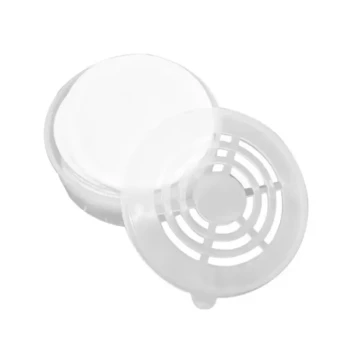The short answer is no, but the full story is more reassuring. A standard bee suit is not technically "wasp-proof," as a determined wasp or hornet can potentially penetrate the fabric. However, a high-quality, properly worn bee suit is the single best piece of personal protective equipment available, and it significantly reduces your risk of being stung by wasps, hornets, and other aggressive insects.
Your goal should not be to find a suit that is absolutely impenetrable, but to use a suit that makes it extremely difficult for a stinger to reach your skin. Protection comes from the gap a suit creates, not just the material itself.

How a Bee Suit Actually Protects You
To understand a bee suit's effectiveness, you must move past the idea of it being a suit of armor. Its design is more clever, relying on space and material thickness to create a formidable barrier.
The Principle of Separation, Not Invulnerability
A bee suit's primary method of protection is its loose fit. The thick fabric creates a significant air gap between the material and your skin.
Even if a wasp's stinger penetrates the outer layer of the suit, it is often too short to cross this gap and reach you. The protection comes from this distance.
Why Fabric and Fit Matter
High-quality suits are made from thick cotton canvas or multiple layers of ventilated mesh. This thickness increases the distance a stinger must travel.
A proper fit is loose and baggy. A cheap or poorly sized suit that is tight against your skin offers almost no protection in those areas.
The Challenge of Wasps and Hornets
Wasps and hornets can be more aggressive than honey bees and may possess slightly longer stingers. They are more likely to attack repeatedly and probe for weaknesses.
While a bee suit is designed for bees, its principles work well against wasps. It remains the best practical option for non-specialized protective gear.
Understanding the Trade-offs and Weak Points
No protective system is perfect. Knowing the potential failure points is critical for ensuring your safety and using the equipment correctly.
Compression Eliminates Protection
The most common point of failure is where the suit is compressed against your body. This happens when you bend your knees, lean on your elbows, or stretch your shoulders.
In these compressed spots, the protective air gap disappears, allowing a stinger to potentially reach your skin. Always be mindful of your posture when near a nest.
Gloves and Boots are Critical Links
Your suit is only as strong as its weakest link. The transition points at your wrists, ankles, and neck are crucial vulnerabilities.
Ensure your gloves overlap your sleeves and your boots overlap your pant legs with no exposed skin. Gloves made from puncture-resistant materials like goatskin leather or thick nitrile offer far more protection than thin latex.
Not All Suits Are Created Equal
There is a significant difference between a cheap, thin cotton suit and a professional-grade ventilated suit. Investing in a higher-quality suit provides a thicker barrier and a better, safer fit.
Making the Right Choice for Your Goal
Your level of protection should match the level of risk you are facing.
- If your primary focus is dealing with an active wasp or hornet nest: A full, high-quality bee suit is non-negotiable. Ensure it is sealed properly at the wrists, ankles, and neck, and pair it with thick leather gloves.
- If your primary focus is beekeeping with occasional wasp encounters: Your standard bee suit is an excellent tool that provides substantial protection, but remain aware of its limitations.
- If your primary focus is general yard work near wasps: A bee suit is likely overkill, but it represents the highest level of personal safety you can achieve if you are particularly concerned or allergic.
Ultimately, a bee suit is a tool that dramatically reduces risk, not a magic shield that eliminates it.
Summary Table:
| Protection Factor | Key Insight |
|---|---|
| Primary Defense | Creates a protective air gap, not an impenetrable barrier. |
| Fabric Quality | Thick cotton canvas or ventilated mesh increases stinger travel distance. |
| Critical Weak Points | Gloves, boots, and areas where suit compresses against the skin. |
| Best Practice | A loose, baggy fit is safer than a tight one. |
Equip yourself with confidence. A high-quality bee suit is your best defense. HONESTBEE supplies professional-grade beekeeping suits and protective equipment to commercial apiaries and distributors. Ensure your team's safety with gear designed for real-world conditions. Contact our wholesale experts today to discuss your needs and get a quote.
Visual Guide

Related Products
- Wholesales Dadant Size Wooden Bee Hives for Beekeeping
- Long Langstroth Style Horizontal Top Bar Hive for Wholesale
- Professional Insulated Winter Hive Wrap for Beekeeping
- Automatic Honey Flow Beehive 4 Frame Mini Hive for Beekeeping
- Plastic Bee Hive Stand for Beekeeping
People Also Ask
- What should beginners consider when purchasing beekeeping equipment? A Guide to Essential Starter Gear
- Why were wooden hives traditionally preferred? For Natural Beekeeping Aligned with Bee Biology
- What are the essential pieces of equipment for most beekeepers? Get Started with the Right Gear
- What are the advantages of wooden bee hives? Superior Bee Health & Beekeeper Flexibility
- What is the best place to keep bees? Find the Perfect Apiary Site for Your Hives



















